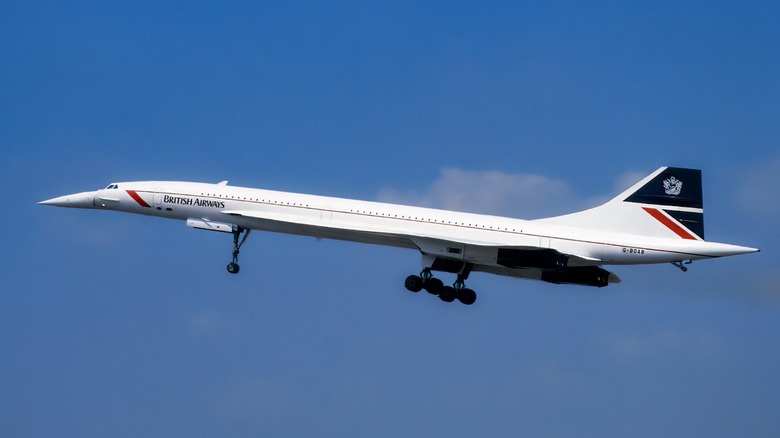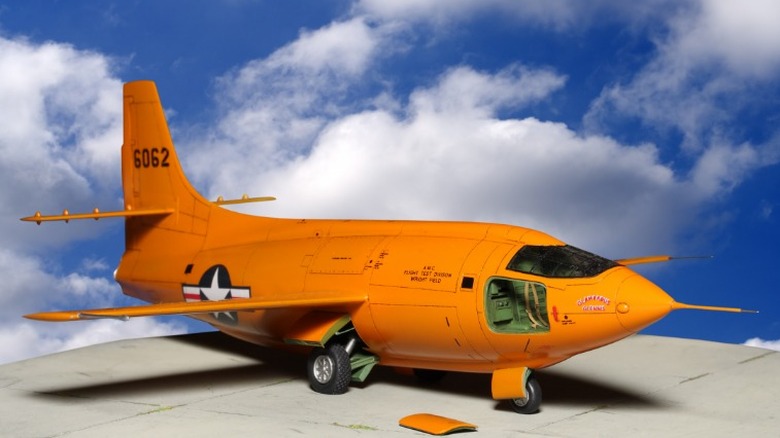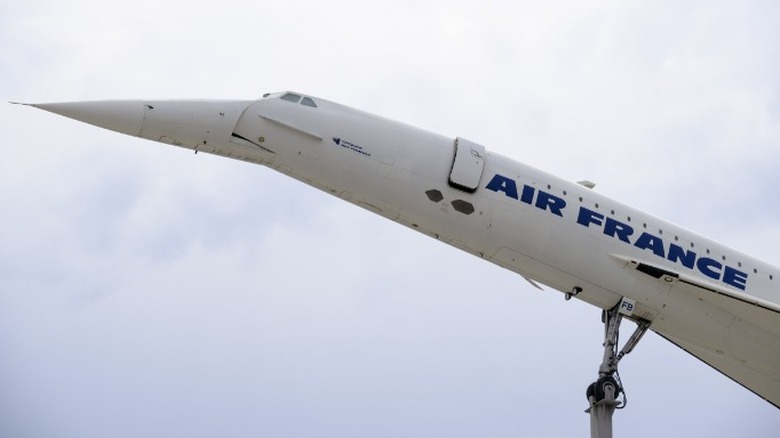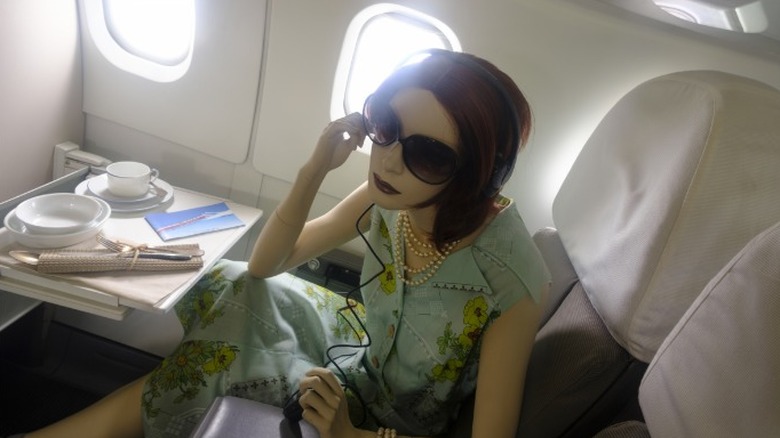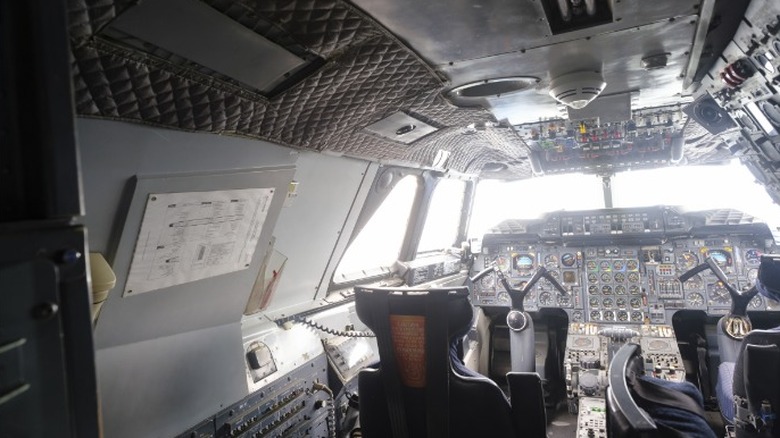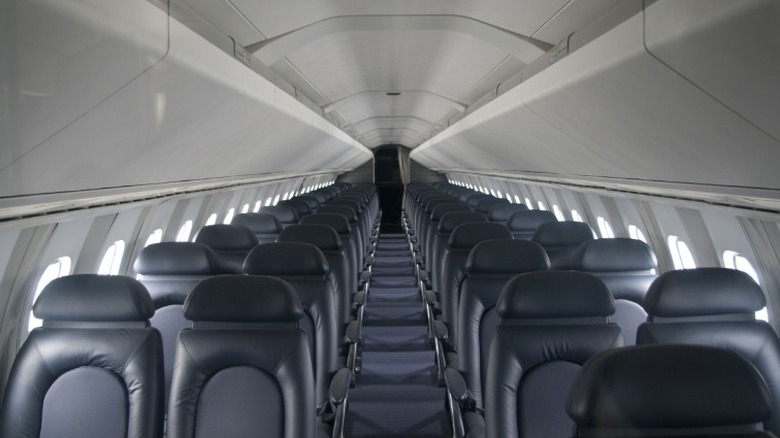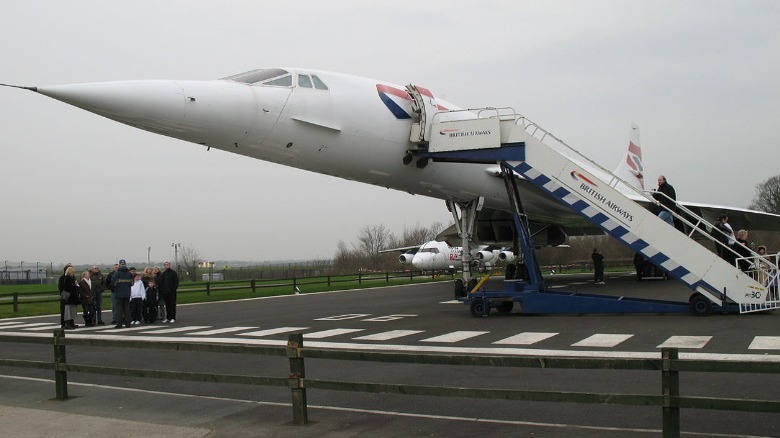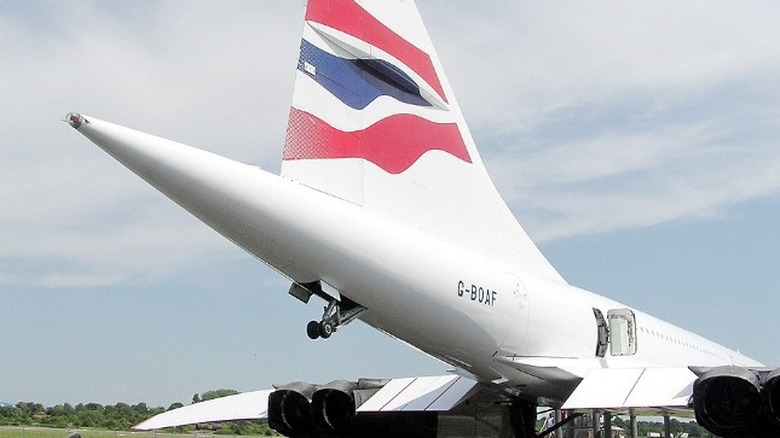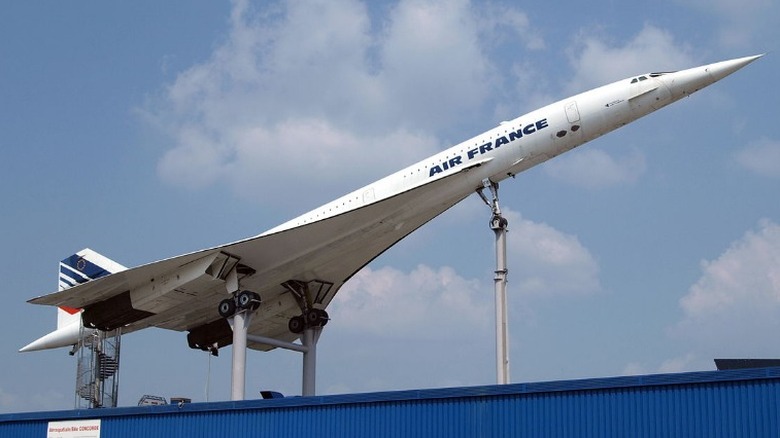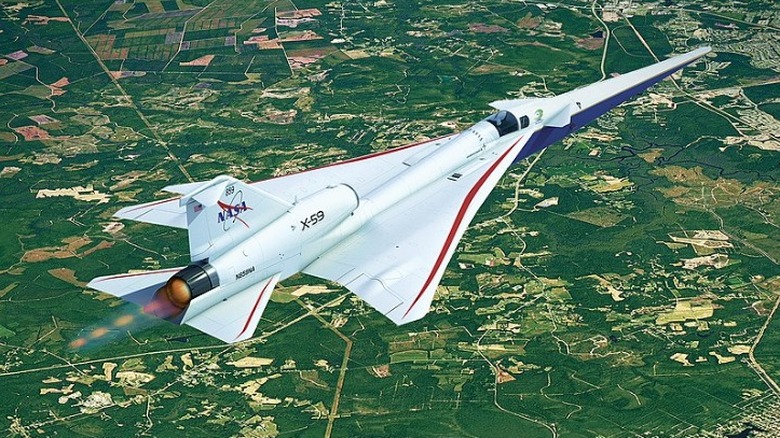The Crash That Killed The Concorde
From 1976 until 2003, passengers in Europe and the U.S. enjoyed supersonic flights across the Atlantic. For a substantial premium, travelers could cut their travel time in half, crossing the Atlantic Ocean in about three and a half hours. Flying on the Concorde was an extremely expensive way to fly. First-class fare from New York to London or Paris averaged around $12,000 in today's money, while first-class tickets for the same route today can be found for about half of that price. However, passengers were treated like royalty and often actually were royalty. Figures such as Queen Elizabeth and Princess Diana were regular passengers, as well as famous characters like Michael Jackson, Elton John, and George Michael.
Concorde flight was unique in every way, from the construction and design of the aircraft to the small and exclusive club of people fortunate enough to have flown on it. Furthermore, the Concorde made its way into popular culture as a status symbol and aspirational experience. Even Roger Moore's James Bond touched down at the Rio airport on a Concorde, which was just one of several destinations for the supersonic jet, and Pepsi once used one as a sort of flying billboard in conjunction with a new product launch. Even though the planes made hundreds of successful flights across the ocean, disaster struck in 2000, and that marked the beginning of the end of the Concorde. The crash and subsequent investigation along with publicity and other external factors led to the closing of the first and last commercial supersonic flight program. These are the details of the crash that killed the Concorde.
Development of the Concorde
With the breaking of the sound barrier by Chuck Yeager in 1947, supersonic flight became a thing just as the jet age shifted into high gear. Consumer air travel grew exponentially with larger jets flying faster and further than ever. By the 1960s, worldwide travel was well established and aerospace engineers and executives sought to bring about every advantage possible, resulting in the development of a supersonic passenger jet (via U.K. Aviation News).
British Aircraft Corporation and Aérospatiale of France — now Airbus Industries — collaborated on a new aircraft meant to fly faster than any other commercial aircraft, which began flying in 1969. It was thought at the time that supersonic travel was the future of commercial aviation. With help from the British and French governments, development got underway and manufacturing took place in both countries.
The plane was met with enthusiasm from both the public and the aviation industry and plans were made to produce dozens of aircraft to be purchased by some of the leading airlines of the day, including Pan-Am, Continental, and United. Problems developed early on that caused plans to be downsized. Concerns from the public and regulators about noise from the sonic booms meant they would be limited to overseas flights only, and the oil crisis of 1973 caused orders to be canceled by carriers struggling to keep current fleets operational and this resulted in a significantly scaled back production (per Business Insider). Nonetheless, the Concorde entered service to the public in 1976.
Concorde specifications and capabilities
A traditional airframe is not suitable for supersonic flight and engineers designed the Concorde with a delta-wing configuration that had been used previously for fighter jets. Rolls-Royce provided four turbojet engines with afterburner capability. These engines were rated to provide up to 38,000 pounds of thrust which could propel the aircraft to a top speed of Mach 2.04, which doubles the speed of sound (1,333 mph). The plane cruised at close to 60,000 feet, nearly double that of a Boeing 777. It accommodated up to 128 passengers with a flight crew of nine, of which three were pilots (via Global Aircraft). While the cabin offered service in accordance with first-class standards, the nature of its construction meant it was fairly cramped, especially compared to modern first-class accommodations.
The Concorde required dozens of unique engineering solutions for successful operation. Besides the Delta-wing configuration, the two most notable details are its nose cone and fuel system. The nose of the plane is unusually long and pointed to reduce drag and that blocks the pilot's view of the tarmac during takeoff and landing (via Simple Flying). Furthermore, the delta wings force the Concorde to land with the nose rotated up significantly more than a typical aircraft. To provide a suitable view, engineers created a sophisticated system to angle the cone down for takeoff and landing and could adjust it to various positions during flight. The fuel system also had to be engineered to move fuel through 17 fuel tanks within the wings to adjust the weight to keep the plane properly balanced while in flight. The tanks also required protection from the extreme heat due to the speeds, as well as leakage and seepage (via Heritage Concorde).
The Concorde experience
With the Concorde being a distinctly luxury experience from the start, passengers received the finest treatment and experience possible from check-in to arrival. Upon entering the plane, travelers would notice the smaller size of it compared to the first-class cabin on a Boeing 747 they might have been accustomed to at the time. CNN tells us that its seating arrangement allowed for a single aisle flanked by two seats on either side and that the cabin felt more like an executive business jet than a luxury airliner. Legroom was sparse but adequate and, in later years, seats included plugs for headsets to listen to a selection of radio stations. In front of the first row was a readout of the altitude, outside temperature, and the Mach speed rating of the aircraft.
Concorde passengers are a well-heeled group accustomed to the finer things in life. Once the requisite announcements and safety demonstrations are out of the way and the aircraft has reached cruising altitude, cabin crew would begin with in-flight service. Caviar was a popular starter, consumed with a glass of perfectly chilled Dom Perignon. Meals of lobster or duck â l'orange were common. With six members of the crew serving only 100 passengers, attention to customer experience was high. And for the lucky ticket holder, a cordial conversation with the passenger in the next seat could have been with Sir Paul McCartney, Sting, or Johnny Cash (via Yahoo! News).
Concorde safety record
Out of the hundreds of flights, none were lost up until the disaster in 2000. That is not to say the plane's track record is spotless, as issues over the years have required attention and repairs. It is common for any aircraft to experience failures of mechanical, hydraulic, and electrical systems, and damage and fatigue in the airframes are expected over the life of the aircraft.
Reporting on the crashed Concorde of 2000, ABC News listed a few previous incidents of note in the history of the Concorde. In the same year of the crash, a plane was grounded after cracks in the airframe were found, and another one was forced to make an emergency landing due to an engine failure. In 1999, a Concorde was forced to return to JFK for fire warnings with crew members subsequently reporting eye and throat irritation. Outer windows shattered at Mach 2 in 1994 and cracks were found in windows during another flight in 1989. The most serious failure happened shortly after the aircraft entered service in 1979 when two tires burst during takeoff, throwing debris and rupturing a fuel tank, according to The Washington Post.
Despite these incidents, the overall safety and track record of the Concorde was very good. Nonetheless, because of the relatively few passengers and few flights compared to typical long-haul flying aircraft, in terms of safety rankings, the single crash put its rating down to dead last.
Air France Flight 4590
On July 25, 2000, a fully booked flight of the Concorde was set to depart from the Paris Charles de Gaulle airport en route to New York. Boarding had been delayed due to a broken thrust reverser, giving mechanics time to resolve the issue. This was a backup plane as the originally planned aircraft had been pulled from service for unrelated repairs. The flight was booked almost entirely by German tourists who were part of a tour group heading eventually to join a cruise in Ecuador. For most of them, this was an extravagant purchase for a once-in-a-lifetime event. The crew included highly experienced pilots, including 53-year-old Captain Christian Marty, who had 317 hours flying the Concorde, a first officer with 10,000 hours, and one engineer who had also accumulated 2,700 hours on the aircraft. This was a competent and capable crew (via Admiral Cloudberg).
Due to some discrepancies with the recording of baggage and underestimates of fuel usage during taxi and takeoff, the plane lifted off slightly overweight, pushing the plane a bit over its maximum threshold. An expected 2,000 kilograms of fuel would be burned before leaving the runway — however, pilots received clearance and initiated takeoff after only burning through 1,000. The plane headed down the runway filling the area with the familiar roar of its four Rolls-Royce engines and lifted off the ground. Just one minute and 10 seconds after receiving clearance, the unthinkable happened and the plane and everyone on board were lost, along with four people in the hotel that the aircraft crashed into.
Crash investigation
As happens with any crash, an investigation began immediately. The French agency conducting the investigation was the Bureau of Enquiry and Analysis for Civil Aviation (BEA). All airplane crashes tend to receive a high degree of publicity and press coverage, but the high profile of the aircraft led the media to devote significant coverage to the crash, becoming the biggest story of the day.
According to the BEA report, the agency was contacted on July 25 about the accident and started gathering a team to assess the situation. The bureau assembled a team including experts from BAE systems, Rolls-Royce, and accredited observers from German and American transportation agencies. On July 26, the French Minister of Equipment, Transport, and Housing established a legal Commission of Enquiry, which assisted the BEA with its work. All Concorde aircraft were temporarily grounded as the investigation began. Eleven meetings were held throughout the investigation in which the BEA shared its findings with the commission. Several other groups were assembled by the BEA with experts from a variety of aviation-related industries to assist with gathering and analyzing information and data. A preliminary report was published by August of the same year with multiple interim reports leading to the final report published on January 16, 2002.
[Featured image by Ralstonjack via Wikimedia Commons | Cropped and scaled | Public domain]
Cause of the crash
As previously mentioned in Admiral Cloudberg's reporting, the flight took off overweight, but that was not deemed to contribute to the accident. Maintenance was also up to date and no malfunctions of any systems had been shown to contribute to the crash, either. The BEA findings show that a strip of metal from another plane taking off just before the Concorde was the cause.
As the plane accelerated down the runway, the front inner tire on the left primary landing gear ran over the debris, causing a slice to the high-pressure tire. This sent chunks of metal and rubber flying in all directions, destroying wiring and the wing's underside. An immediate stream of fuel burst from the tank, flowing back toward the engine, and ignited due to a short circuit from exposed wiring. Fire expanded from under the left wing, causing two engines to lose power. The plane veered left toward a Boeing 747 with French President Jacques Chirac on board before the Captain, knowing the Concorde was on a direct collision course with the President's plane, corrected the plane to the right, which also caused the nose to lift for takeoff. As the plane lifted off, calls from traffic control announced that Concorde was on fire and pilots attempted to point the aircraft toward a nearby municipal airport, trying to avert disaster.
The plane failed to gain enough speed to continue to climb and it quickly became impossible to control and correct for the engine failure and lack of speed. As the pilots furiously attempted to gain control, the plane rolled sharply to the left, followed by a spiral toward the ground. The flight recorder caught a final desperate "No!" from the First Officer just before Concorde plowed into the l'Hôtelissimo and erupted into a massive fireball.
[Featured image by Adrian Pingstone via Wikimedia Commons | Cropped and scaled | Public domain]
Fallout and subsequent aviation changes
While Concorde flights eventually resumed and procedural changes were implemented, its days were already numbered. Supersonic flight for a limited number of passengers used an extraordinarily large amount of fuel and, by 2000, the danger of continued burning of hydrocarbons was already well publicized. Additionally, changes in the variation industry following the September 11th terrorist attacks and the recession of the early 2000s contributed to the woes of the airlines.
Following the report of Air France Flight 4590, many recommendations were made for maintenance and protocol for readying aircraft for flight. In an accident investigation report by Captain Michael De Vere, Ph.D, the Concorde should have upgraded Kevlar fuel cells, shielding to wiring on the landing gear to prevent fire, upgraded tires, and other mechanical and operational upgrades. There should also be additional inspections of runways prior to giving authorization and the ability of pilots to see aircraft structures obscured from their field of view.
French authorities charged Continental airlines and a maintenance mechanic criminally for causing the accident due to the metal strip that fell off of the airline's DC-10, according to the BBC. Courts found them both liable, fining Continental €200,000 and sentencing the mechanic to 15 months incarceration for the charge of manslaughter. An appeals court later overturned the convictions but allowed a civil infraction against the airline to stand along with its €1 million award.
[Featured image by Alf van Beem via Wikimedia Commons | Cropped and scaled | CC0 1.0 ]
Legacy of supersonic flight
While the crash was not the sole reason Concorde service ended, it contributed significantly. Its final flight was in October of 2003, and no plane has since replaced it on any route. The truth of the Concorde is that it was extremely expensive to operate and without any overland routes, the number of passengers curtailed the ability to recoup development costs. Slate reports that the extreme sonic booms were found early on to be too much of a disruption on the ground, relegating supersonic flight to be regulated only to necessary military operations. Other ideas have come and gone, but nobody has yet been willing to put up the funding to explore them to a large degree.
Recently, however, NASA has been developing a new kind of supersonic jet that is theoretically designed to minimize or eliminate the sonic boom phenomena. Initial test flights are scheduled for 2023 and they will provide NASA with a wealth of information on supersonic flight characteristics that will aid in future designs. No plans exist at the moment to develop this into a passenger aircraft, but it is conceivable that data collected could be used toward that end. Regardless of what information is gleaned, environmental impacts will not be overcome so easily.
For the most part, executive flying at Mach 2 will remain a fond memory and the Concorde will continue to exist as a museum piece and as scale models for hobbyists. As to whether supersonic flight will return, it is safe to say that human innovation will likely overcome the major obstacles currently blocking such developments, but when that will happen is still anybody's guess.
[Featured image by NASA Headquarters via Wikimedia Commons | Cropped and scaled | Public domain ]
